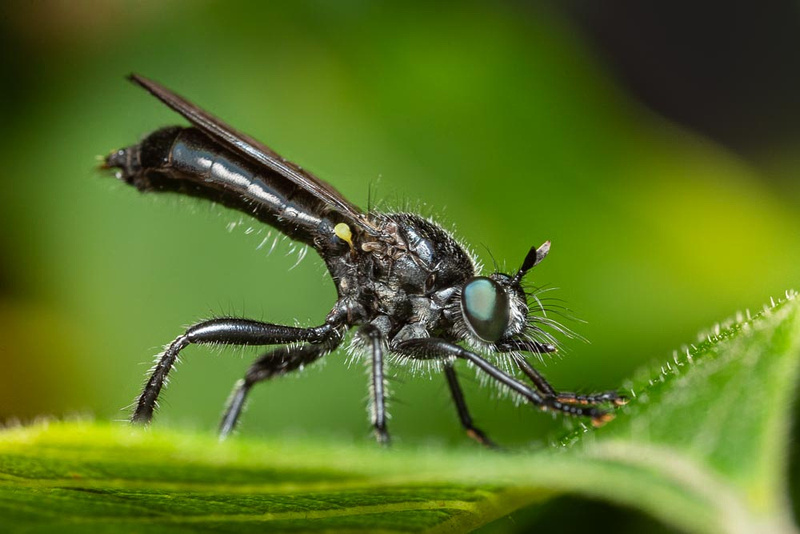We have endured unseasonably high temperatures here in Minnesota during the last several days, but the winds switched around last night and after a rainstorm yesterday the temperatures dropped into the unseasonably cold mid-fifties, which is about 40F colder than our high temperature just a few days ago.
Low temperatures are both a curse and a boon for insect macrophotography. Insects are more active in warm temperatures making them easier to find while cold temperatures have them scrambling--albeit more slowly--to find cover. That, of course, makes them harder to find but easier to photograph once they are found as they are less likely to startle, flee, or hide. While chilled insects slow down, they are still capable of scurrying or flying off so moving slowly around them is still advisable. But having a semi-torpid subject provides the photographer with more time to contemplate and compose the photograph. An added benefit is that there are fewer mosquitoes to bother the photographer's concentration...grin.
I found this robber fly perched on a leaf this morning trying to warm up.
 Robber FlyRobber flies often lurk on leaves, as this one is doing, to either warm up or to ambush their prey.
Robber FlyRobber flies often lurk on leaves, as this one is doing, to either warm up or to ambush their prey. Robber flies have a worldwide distribution with just under a thousand species in the United States. They come in all sorts of shapes and sizes, including some that resemble bumblebees. They also seem to prefer drier areas. In Minnesota, I find most robber flies in sand prairies, but they will also show up in our suburban yard. Robber flies are predators and hunt primarily flying insects although they may also take spiders on occasion. They often sit in ambush on leaves like this one is doing and watch for passing insects. They are fast, agile, and powerful fliers that track their prey down in mid-air, intercept and grasp prey in their powerful legs, and carry it to a convenient perch for consumption. I don't know if they can calculate angles and anticipate how to plot an intercept course with their prey as some research suggests dragonflies do or if they simply overtake their prey from behind. Regardless of their pursuit methodology they have both excellent eyesight and great awareness of their surroundings making them quite difficult to approach, although some species are easier to approach than others. Those robber flies that have caught and are feeding on prey also tend to be a bit easier to approach.
Robber flies have a worldwide distribution with just under a thousand species in the United States. They come in all sorts of shapes and sizes, including some that resemble bumblebees. They also seem to prefer drier areas. In Minnesota, I find most robber flies in sand prairies, but they will also show up in our suburban yard. Robber flies are predators and hunt primarily flying insects although they may also take spiders on occasion. They often sit in ambush on leaves like this one is doing and watch for passing insects. They are fast, agile, and powerful fliers that track their prey down in mid-air, intercept and grasp prey in their powerful legs, and carry it to a convenient perch for consumption. I don't know if they can calculate angles and anticipate how to plot an intercept course with their prey as some research suggests dragonflies do or if they simply overtake their prey from behind. Regardless of their pursuit methodology they have both excellent eyesight and great awareness of their surroundings making them quite difficult to approach, although some species are easier to approach than others. Those robber flies that have caught and are feeding on prey also tend to be a bit easier to approach.
This robber fly allowed a close approach in this morning's cold air. In fact, it was so docile I was able to pluck a nearby leaf that was partially blocking my view without disturbing it. Even then the composition wasn't right so I carefully removed the leaf on which the fly was sitting and moved it to a more desirable background, something neither action would be tolerated by robber flies in warmer weather.
Equipment used for this photo:
- Sony A7III
- Sony flash with diffuser
- Canon MP-E65 macro lens set to 1:1
- Handheld